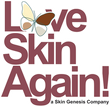Facial care and skin types
FACIAL CARE TIPS by LOVE SKIN AGAIN DIVISION OF SKIN GENESIS
Dedicated to the transformation and rejuvenation of your skin
- Use facial scrub 1 to 3 times per week as needed for skin type and condition.
- Important to wash hands before touching your face.
- Do not pick at outbreak (pimples, blackheads, whiteheads).
- To cleanse: wet face with warm not hot water, take small amount of scrub into handsand rub in circular motion over face, rinse with warm then cool water.
- Pat face dry with towel. (Keep face towel clean, dry and only used on face).
- Apply moisturizer: daytime – appropriate for skin type and a sunscreen is important. Nighttime – after cleansing us a moisturizer ora small amount of coconut oil.
- In morning wash face with warm water - cool water - pat dry.
- When wearing make-up make sure to remove completely before bedtime.
- When applying make-up do not use finger tips but use a makeup brush or sponge. Place makeup on top of non-dominate hand. Dip brush or sponge into makeup and apply to face.
- Wash make-up brushes frequently to prevent outbreaks.
- Change make-up brushes yearly or as often based on quality of brushes.
- Scrubs by “Love Skin Again” have several oils in the blends and is acceptable for use on oily skin. Oils may come to the surface of the face and cause an outbreak that may last for 3 days. The outbreak is usually in the form of whiteheads. Use of a facial scrub will generally help to eliminate facial outbreak.
CHARACTERISTICS OF SKIN TYPES
NORMAL SKIN TYPE
- Not too dry and not too oily
- No or few imperfections
- No severe sensitivity
- Barely visible pores
- A radiant complexion
DRY SKIN TYPE
- Almost invisible pores
- Dull, rough complexion
- Red patches
- Your skin is less elastic
- More visible lines
OILY SKIN TYPE
- Enlarged pores
- Dull or shiny, thick complexion
- Blackheads, pimples, or other blemishes
SENSITIVE SKIN TYPE
- Redness
- Itching
- Burning
- Dryness
- Possible triggers associated to products or foods that increase sensitivity.
